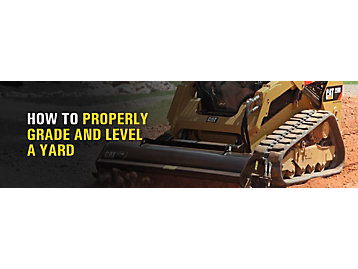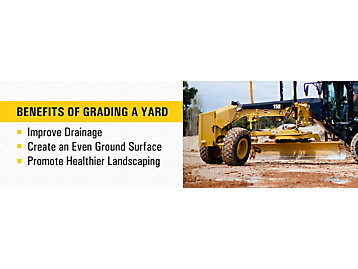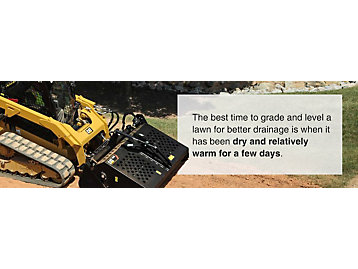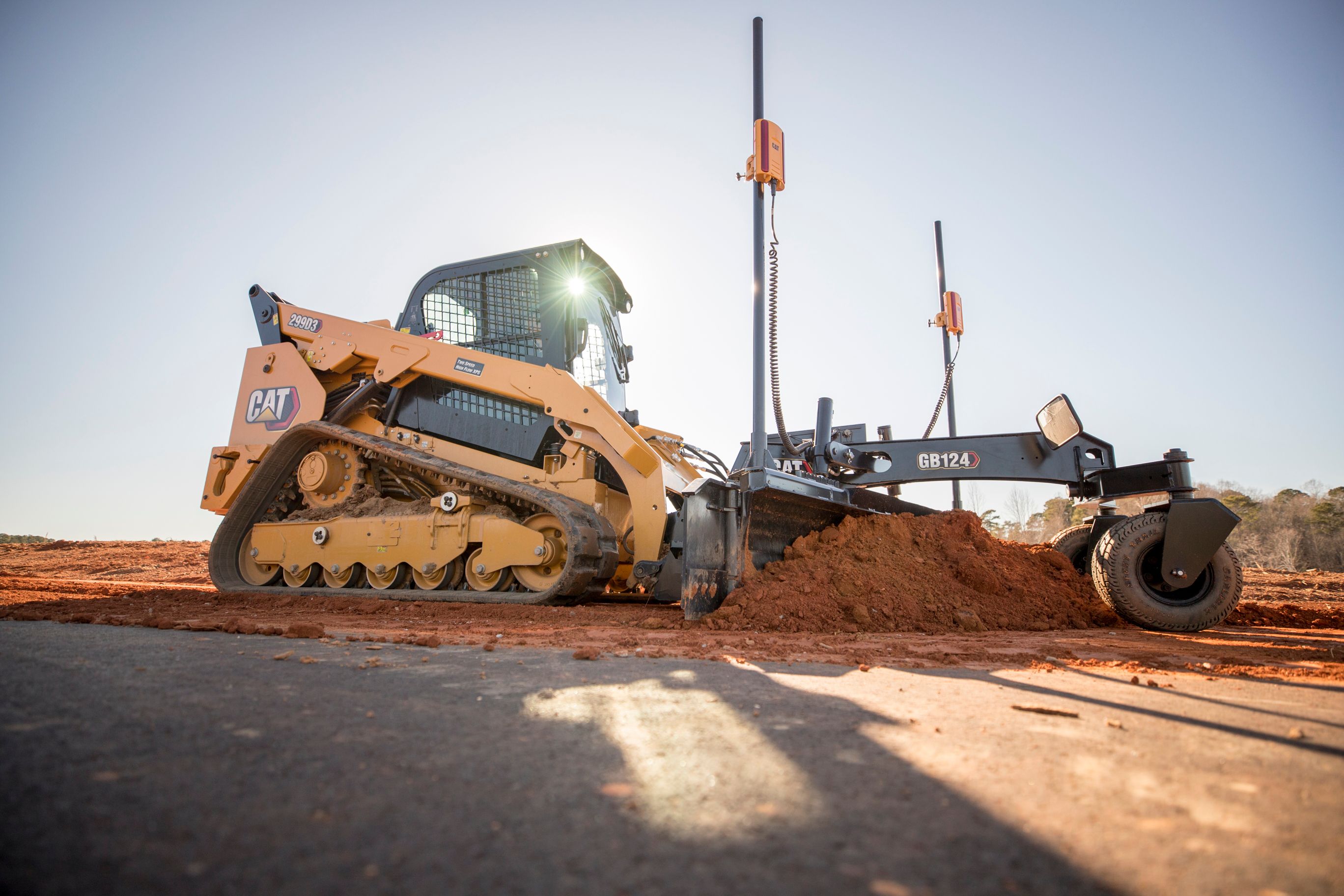

Sign In
Welcome! Sign In to personalize your Cat.com experience
If you already have an existing account with another Cat App, you can use the same account to sign in here
Register Now
One Account. All of Cat.
Your Caterpillar account is the single account you use to log in to select services and applications we offer. Shop for parts and machines online, manage your fleet, go mobile, and more.
Account Information
Site Settings
Security
Author: Small Business Expert | March 11, 2024 | Topic: Used Equipment

Grading and leveling a soggy or uneven yard is an effective way to protect a building's foundation and avoid other issues in the future. Knowing the right equipment and best practices for grading the ground can save you time, energy and money.
Learn everything you need to know in this yard grading and leveling guide to complete any job effectively and correctly.
What Is Yard Grading?
Grading refers to the process of using equipment to create a slight slope in a lawn, which promotes better water drainage and improves the ground's surface. In addition to correcting drainage issues, yard grading is essential in order to complete these projects:
- Correcting surface damage
- Installing a pool, pond or other water feature
- Placing sewer components
- Removing bulky tree roots
- Eliminating any bumps, lumps and divots that can pose a safety concern
Yard Grading Considerations
Before you begin any yard grading and leveling project, it's important to assess the property and consider the following factors:
- Yard conditions: The ground's surface will impact the grading process because it involves removing the topsoil. There may be rocks, roots or other materials that require removal before firing up your grading equipment.
- Desired slope: To achieve the best drainage solution, you must create an incline in the yard with a slope as small as 3% or as severe as 25%.
- Distance from the house: The furthest area from the house or building structure should be the lowest point in the lawn to maximize water drainage away from the foundation.
5 Signs You Should Consider Yard Grading
Not sure whether a specific property needs grading? Here are some telltale signs that landscape grading and leveling are needed:
- Spongy soil: If a yard feels squishy and stays moist long after a rain shower, it likely needs an updated drainage solution.
- Rotting grass: Splotchy, thinning and brown grass could be the result of too much water saturation.
- Soil erosion: Uneven lawns with poor water drainage can lead to soil erosion, especially around the building itself.
- Mosquitos: Standing water attracts pests like mosquitos that can pose a health threat.
- Leaks or water stains: If there are water leaks or stains below a property's foundation, like in a basement, this is likely a result of inadequate drainage.
What Are the Benefits of Grading a Yard?
Grading a lawn is a sizeable project, but the advantages of completing this job are worth the investment. Here are some of the key benefits of grading.

Improve Drainage
Yard grading enhances the property's water drainage system by reshaping the ground. Proper drainage means a dryer, healthier lawn that residents can enjoy. It also protects the house's foundation from deterioration over time.
By sloping the ground away from the foundation, you can help save building structures from expensive water damage, such as:
- Foul smells
- Pests
- Mold or mildew growth
- Leaks
- Indoor humidity
- Foundation cracks
Create an Even Ground Surface
A level, even surface on a property makes new construction and landscaping projects much easier. For example, if a homeowner wishes to install a pool or construct an add-on, the first step will likely be to verify the ground is level. Another benefit is ensuring a property is safe for people to walk on without the risk of injury due to divots and bumps.
Promote Healthier Landscaping
Yard grading projects for better drainage lead to healthier landscaping overall. Trees, bushes and other plants can grow more freely when there isn't excess water pooling in the grass. Removing the possibility of standing water also helps combat pests, like mosquitos, ants and rodents.
In addition, a properly graded lawn looks better and can increase a property's value. Creating the most attractive property possible is easier with a yard designed to optimize drainage.
What Equipment Should Be Used for Landscape Grading?
There are a few types of heavy equipment that come in handy for landscape grading projects, including:
- Motor graders: The most popular option is a motor grader, which can be useful for high precision or general grading applications.
- Bulldozers: You can utilize a bulldozer to remove unwanted plants, roots and debris from the yard. These machines can also be useful for leveling and filling large divots or trenches.
- Skid steer loaders: A skid steer loader can be helpful for rough grading or backfilling projects.
- Wheel tractor scrapers: Wheel tractor scrapers can aid in landscape grading applications, especially for leveling and earthmoving tasks.
How to Properly Grade and Level a Yard
The best time to grade and level a lawn for better drainage is when it has been dry and relatively warm for a few days. A moist or frozen yard can complicate the process and interfere with completing the project successfully.

Follow these eight steps to grade a yard:
- Prep the lawn: Begin by cutting the grass. Be sure not to cut it too short, which can cause the lawn to dry out. It's also important to assess if there is any vegetation, excess thatch or debris that needs removing.
- Mark high and low points: Use a stake or yard flag to identify any raised points and low points where water isn't draining.
- Remove grass from sunken areas: Dig up the grass from any sunken areas that are deeper than a couple inches.
- Fill sunken areas and divots: Add topsoil to low spots to even out the lawn and create a smoother, more even surface.
- Establish your grade slope: Use a laser or string to guide your grade slope.
- Grade the area: Use your choice of heavy equipment to shape the yard according to the intended grade slope. Afterward, assess the lawn for any inconsistencies and adjust them as needed before moving on to the next step.
- Compact the soil: After grading, you'll utilize a soil compactor to create a firm, even surface. Compacting will also help reduce muddiness and erosion in the yard when it rains.
- Water your soil: Add water and grass seed to the yard to promote healthy regrowth.
Browse Used Heavy Equipment Today
When you need a motor grader, skid steer loader or another piece of equipment, explore the Cat® Used inventory. You can find used machines, attachments and accessories from the extensive Cat dealer network. Plus, set up email alerts for specific pieces of equipment to get notified when a model becomes available from your local Cat dealer.
Browse the inventory or find a Cat dealer near you today.



